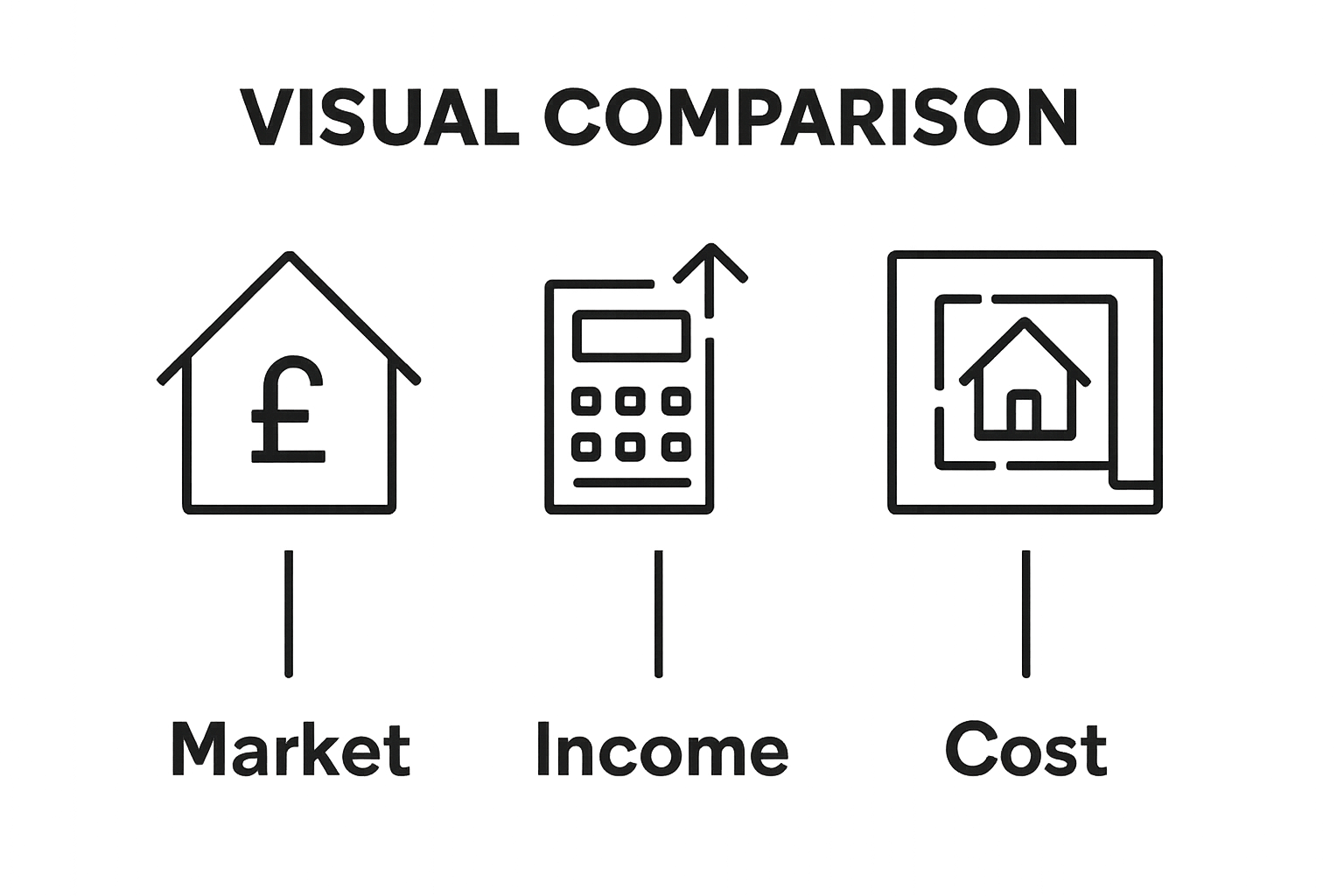HMO valuation is turning heads among property investors and landlords. The process is not just about counting bedrooms or measuring square footage but dives deep into what makes a multi-tenant property a winner. Surprising as it might sound, a top-quality HMO can deliver rental yields up to 10 percent higher than standard buy-to-lets. The twist is that true value lies far beyond the price tag, and the figures you uncover are often shaped as much by careful compliance and smart configuration as by the postcode.
Quick Summary
| Takeaway | Explanation |
|---|---|
| HMO valuation assesses income potential | It focuses on the total expected rental revenue from multiple tenants, central to valuation accuracy. |
| Methodologies include income capitalisation | This method evaluates properties based on their ability to generate rental income, crucial for HMOs. |
| Location significantly impacts value | Proximity to universities and amenities can enhance rental demand and income potential. |
| Compliance affects property valuation | Regulatory compliance and licensing are vital for achieving higher valuations and potential income. |
| Valuations inform investment strategies | Detailed assessments guide better financial decisions, risk management, and portfolio diversification. |
Defining HMO Valuation: What It Is
HMO valuation represents a specialised property assessment process designed to determine the precise financial worth of Houses in Multiple Occupation (HMO). Unlike standard residential property valuations, HMO valuations incorporate complex factors that reflect the unique characteristics and income-generating potential of multi-tenant properties.
Understanding the Core Concept
At its fundamental level, HMO valuation examines multiple dimensions beyond traditional property valuation methods. Investors and property professionals assess the property’s value through a comprehensive lens that considers several critical elements:
- Rental Income Potential: The total expected monthly rental revenue from multiple tenants
- Property Configuration: Number of rooms, communal spaces, and potential occupancy levels
- Location and Amenities: Proximity to universities, employment centres, and transport links
According to RICS Valuation Standards, professional valuers must consider these intricate factors to provide an accurate financial assessment that reflects the property’s true market value.
Key Valuation Methodologies
Professional HMO valuations typically employ multiple approaches to establish a property’s worth. These methodologies include comparative market analysis, income approach, and cost approach.
 The income approach is particularly significant for HMOs, as it directly evaluates the property’s potential to generate consistent rental revenue.
The income approach is particularly significant for HMOs, as it directly evaluates the property’s potential to generate consistent rental revenue.
Property investors seeking to sell HMO property must understand that HMO valuation goes beyond simple square footage calculations. It requires a nuanced understanding of local rental markets, tenant demographics, and potential future income streams.
Crucially, HMO valuations differ from standard residential property assessments by emphasizing the property’s investment potential rather than just its physical characteristics.
The following table compares the principal HMO valuation methodologies referenced in the article, highlighting their features and specific relevance in valuing Houses in Multiple Occupation (HMOs).
| Valuation Methodology | Focus Area | Typical Application for HMOs | Key Consideration |
|---|---|---|---|
| Comparative Market Analysis | Recent HMO sales and market data | Establishes a baseline using similar nearby properties | Adjusted for unique HMO features |
| Income Capitalisation Approach | Rental income and operational expenses | Measures value by property’s net rental revenue | Emphasises yield and income consistency |
| Cost Approach | Rebuild/replacement cost | Sometimes used for newly converted or unique HMOs | Accounts for depreciation and compliance |
| Valuers examine factors such as current rental yields, potential for room rate increases, occupancy consistency, and the property’s compliance with local HMO licensing regulations. |
The Importance of HMO Valuation in Property Investment
HMO valuation plays a pivotal role in property investment strategy, offering investors a comprehensive financial framework for assessing the potential profitability and long-term viability of multi-tenant properties. By providing a detailed analysis of a property’s income-generating capabilities, HMO valuations serve as a critical decision-making tool for property investors seeking to maximise their returns.
Strategic Financial Planning
Investors rely on HMO valuations to make informed decisions about property acquisitions, improvements, and potential future developments. These valuations offer crucial insights that go beyond traditional property assessments:
- Risk Assessment: Identifying potential financial vulnerabilities and market risks
- Investment Comparison: Enabling precise comparisons between different HMO investment opportunities
- Financial Forecasting: Predicting potential rental income and property appreciation
According to UK government guidance on property valuation, understanding the nuanced methods of property assessment is fundamental to making sound investment decisions.
Maximising Investment Returns
HMO valuations provide investors with a granular understanding of a property’s true financial potential. By examining factors such as local rental markets, occupancy rates, and potential room configurations, investors can strategically position their properties to generate optimal returns.
Property investors looking to buy and sell HMO properties must recognise that accurate valuations are more than just financial exercises. They represent a sophisticated approach to understanding the intricate dynamics of the multi-tenant property market.
Beyond immediate financial considerations, HMO valuations also help investors anticipate future market trends, regulatory changes, and potential modifications that could enhance a property’s value. This forward-looking perspective is crucial in a dynamic and competitive property investment landscape, enabling investors to make proactive decisions that align with long-term financial goals.
Key Factors Influencing HMO Valuation
HMO valuation is a complex process influenced by multiple interconnected factors that extend far beyond traditional property assessment methods. Understanding these nuanced elements is crucial for investors seeking to accurately determine an HMO property’s true market value and potential returns.
Property Characteristics and Configuration
The physical attributes of an HMO play a significant role in its valuation. Professional valuers meticulously examine several key structural and functional elements:

- Room Sizes and Layout: Number of lettable rooms, floor space, and overall property configuration
- Occupancy Potential: Maximum number of tenants the property can legally accommodate
- Communal Space Quality: Size and functionality of shared areas like kitchens and living spaces
According to UK government guidance on HMO regulations, compliance with minimum room sizes and safety standards directly impacts a property’s valuation and investment potential.
Location and Market Dynamics
Geographical positioning and local market conditions substantially influence HMO property values. Investors must consider factors such as proximity to universities, employment centres, public transportation, and local amenities. These elements determine the property’s attractiveness to potential tenants and, consequently, its rental income potential.
Those looking to sell HMO property must recognise that location-specific attributes can significantly enhance or diminish a property’s market value.
Regulatory Compliance and Income Generation
HMO valuations are intrinsically linked to regulatory compliance and demonstrable income potential. Professional valuers assess:
- Licensing Status: Current HMO licensing compliance
- Rental Yield: Historical and projected rental income
- Operational Costs: Maintenance expenses and potential renovation requirements
Investors must understand that a well-maintained, compliant HMO with consistent rental performance will invariably command a higher valuation in the competitive property market.
This table summarises the main factors that influence HMO valuation, providing a concise overview of critical elements investors and valuers must evaluate.
| Factor | Description | Impact on Valuation |
|---|---|---|
| Rental Income Potential | Projected monthly and annual rental revenue | Higher income yields raise value |
| Property Configuration | Number of rooms, communal space quality, occupancy level | More rooms, better layout = higher value |
| Location and Amenities | Proximity to universities, employment, transport, services | Increased demand boosts value |
| Regulatory Compliance | HMO licence, safety standards, local regulations | Compliance is essential for valuation |
| Occupancy Rates | Consistency and reliability of tenant occupancy | Stable occupancy increases value |
| Operational Costs | Maintenance, management, and renovation expenses | Lower costs improve net yield |
How HMO Valuation Works: Principles and Methods
HMO valuation represents a sophisticated process that integrates multiple analytical approaches to determine a property’s comprehensive financial worth. Unlike standard residential property assessments, HMO valuations require a more nuanced and multifaceted evaluation methodology that considers unique characteristics of multi-tenant properties.
Comparative Market Analysis
The comparative market analysis method forms a foundational approach in HMO valuation. Professional valuers systematically examine similar properties within the same geographical area to establish a baseline market value. This method involves:
- Comparable Property Assessment: Analyzing recently sold HMO properties with similar characteristics
- Market Trend Evaluation: Understanding local rental market dynamics
- Price per Room Calculation: Determining average rental rates for comparable properties
According to Valuation Office Agency guidance, the comparative approach provides a robust initial framework for understanding property value.
Income Capitalisation Approach
The income capitalisation method represents a critical valuation technique specific to HMO properties. This approach directly assesses the property’s potential to generate rental income by examining:
- Gross Rental Income: Total potential monthly rental revenue
- Operational Expenses: Maintenance, licensing, and management costs
- Net Operating Income: Projected annual income after deducting expenses
Property investors looking to sell HMO property must understand that this method transforms potential rental income into a comprehensive property valuation.
Risk and Compliance Considerations
Modern HMO valuations integrate comprehensive risk assessment protocols. Valuers meticulously evaluate regulatory compliance, potential licensing restrictions, and property-specific risk factors. This approach ensures that the valuation reflects not just current market conditions but also potential future challenges and opportunities inherent in multi-tenant property investments.
Real-World Applications of HMO Valuation
HMO valuation extends far beyond theoretical financial calculations, serving as a critical tool for diverse stakeholders in the property investment ecosystem. By providing comprehensive insights into a property’s financial potential, HMO valuations influence strategic decisions across multiple professional domains.
Investment and Financial Decision Making
Professional investors leverage HMO valuations as a fundamental mechanism for assessing potential property investments. These detailed assessments enable sophisticated financial strategies by offering:
- Risk Management: Identifying potential financial vulnerabilities in property investments
- Portfolio Diversification: Evaluating potential HMO properties for strategic investment
- Capital Allocation: Determining optimal investment resources and potential returns
According to research from the University of Reading, precise property valuation plays a crucial role in understanding broader economic and social housing dynamics.
Lending and Mortgage Considerations
Financial institutions rely extensively on HMO valuations when making lending decisions. Mortgage providers conduct rigorous assessments to determine the viability and risk associated with HMO property investments. This process involves:
- Loan-to-Value Ratio: Calculating potential lending limits
- Investment Potential: Assessing the property’s income generation capacity
- Regulatory Compliance: Ensuring the property meets lending standards
Property investors looking to sell HMO property must understand that a comprehensive valuation can significantly impact their ability to secure financing.
Regulatory Compliance and Policy Development
HMO valuations play a crucial role in developing housing policies and ensuring regulatory compliance. Government agencies and local authorities utilise these assessments to:
- Urban Planning: Understanding housing market trends
- Licensing Requirements: Determining appropriate standards for multi-tenant accommodations
- Social Housing Strategies: Informing policy decisions about housing affordability and accessibility
These real-world applications demonstrate that HMO valuation is not merely a financial exercise but a sophisticated tool with wide-ranging implications for property investment, lending, and urban development.
Unlock the True Value of Your HMO with Our Expert Solutions
Understanding the complexities of HMO valuation is essential for any landlord or investor aiming to maximise returns. The article highlights how difficult it can be to accurately assess properties with multiple tenants, factor in income potential, ensure compliance, and stay ahead of regulatory shifts. If you are concerned about missed income opportunities or unsure whether your HMO meets current valuation standards, you are not alone. Many landlords and property investors face the same uncertainty when trying to position their HMO properties for sale or refinance.
The good news is that you do not have to navigate these challenges alone. AgentHMO is tailored to solve these very issues. Explore our comprehensive tools and guidance for selling HMO property. Find the support you need in our directory of expert HMO agents and services. With our platform, you can access specialist valuations, connect with professional advisors, and stay updated on market trends relevant to your investment goals. Ready to secure the best outcome for your multi-let property? Visit AgentHMO today and take the next step towards a confident and rewarding HMO transaction.
Frequently Asked Questions
What is HMO valuation?
HMO valuation is a specialised property assessment process that determines the financial worth of Houses in Multiple Occupation (HMO), taking into account rental income potential, property configuration, and location.
How does HMO valuation differ from standard property valuation?
Unlike standard property valuations that focus primarily on physical characteristics, HMO valuations emphasise the investment potential and income-generating capabilities of multi-tenant properties.
What key factors influence HMO valuation?
Key factors include property characteristics (such as room sizes and layout), location and market dynamics, regulatory compliance, and proven income generation potential for the property.
Why is HMO valuation important for property investors?
HMO valuation is crucial for investors as it informs their decisions on property acquisitions, helps assess risk and potential profits, and guides financial planning and forecasting for better investment outcomes.


